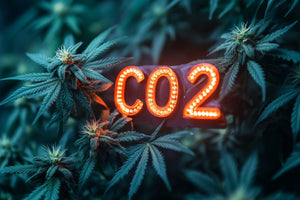plants growers face a common challenge: boosting yield. While many optimize factors like lighting, temperature, and humidity, one often overlooked but critical factor is carbon dioxide (CO₂). Research shows that increasing CO₂ concentration can enhance cannabis flower yields by up to 30%.
1. What is Carbon Dioxide?
Carbon dioxide (CO₂) is a colorless, odorless gas composed of one carbon atom and two oxygen atoms. Plants produce the energy they need to survive through photosynthesis, using CO₂ as a key raw material. In this process, plants combine CO₂ with water and, using sunlight, convert it into glucose and oxygen.
2. The Impact of CO₂ on Cannabis Growth
CO₂ is essential for photosynthesis. Without it, plants struggle to photosynthesize effectively, leading to poor growth. In nature, the CO₂ concentration is around 400 ppm (parts per million), which is insufficient for high-demand crops like cannabis.
By raising CO₂ levels to between 1,000 and 1,500 ppm, cannabis growth can accelerate by 20-100%, and yields can increase by 20-30%, resulting in taller, stronger plants with higher commercial value.
3. When Should You Use CO₂?

CO₂ is most beneficial during the mid-vegetative stage, when cannabis is growing rapidly.
This stage typically lasts for 2-5 weeks before flowering begins. Introducing CO₂ during this period significantly enhances photosynthesis efficiency. Increasing CO₂ to 1,000-1,500 ppm allows plants to absorb light and convert it into energy more rapidly, promoting faster growth.
4. What is the Optimal CO₂ Concentration for Plants?
While 1,500 ppm of CO₂ can maximize yields and growth speed, this increase comes with higher equipment costs.
Growers must weigh the investment against expected returns. Most growers find that 800-1,000 ppm is easy to manage and highly effective, providing a noticeable boost in growth speed. However, some professional growers push CO₂ levels to 1,500 ppm to balance investment and yield, especially with modern LED grow lights capable of delivering 2,000 μmol/m²/s of light.
5. How to Match CO₂ Levels with Light Intensity at Different Growth Stages

-
Seedling Stage: Seedlings require minimal CO₂. 200-300 μmol/m²/s PPFD with fresh air suffices. Excess CO₂ can stunt growth.
-
Vegetative Stage: This phase requires plenty of "fuel," with 600-1,000 μmol/m²/s of PPFD needed. CO₂ levels can be raised to 600-1,000 ppm, ideally reaching 1,000 ppm for best results.
-
Flowering Stage: During flowering, plants need intense light and higher CO₂ levels. Aim for 1,000-1,200 μmol/m²/s of light intensity, maintaining CO₂ at 1,000-1,300 ppm.
-
Final Push: In the last few weeks of flowering, increase light intensity to 1,500-2,000 μmol/m²/s, using a 1200W grow light, and raise CO₂ to 1,500 ppm. Some growers observe growth rates doubling at this stage, but this requires robust equipment and budget considerations.
6. How to Calculate the Required Amount of CO₂
To calculate the necessary CO₂ amount, consider the size of your grow room. For example, if your grow room has a volume of 40 cubic meters and you aim to raise CO₂ from 400 ppm to 1,500 ppm, you need an increase of 1,100 ppm.
Use the formula:
CO₂ amount (liters) = Room volume (cubic meters) × CO₂ increase (ppm) / 1,000,000
In this example:
40 × 1,100 / 1,000,000 = 0.044 cubic meters = 44 liters
7. How to Add CO₂ to Your Grow Room
There are several methods to add CO₂ to your grow room, depending on your budget, grow size, and technical skills:
1. CO₂ Generators
These devices generate CO₂ by burning natural gas or propane, making them suitable for large-scale grows. However, they can produce harmful gases like carbon monoxide, so proper ventilation and safety measures are crucial.
2. CO₂ Tanks
Suitable for medium to small grow rooms, CO₂ tanks allow for precise control over CO₂ release using a regulator and timer. They can be costly and require periodic refilling.
3. CO₂ Bags
Ideal for small to medium spaces, CO₂ bags release CO₂ slowly over time. They are easy to use but may not allow for precise control of CO₂ levels.
Conclusion
By controlling CO₂ levels alongside light, temperature, and humidity, growers can achieve more bountiful harvests. However, it’s crucial to apply CO₂ in the right amounts, scientifically and reasonably, to avoid the risks associated with overuse. Managing CO₂ effectively can lead to significantly improved yields and more successful growing outcomes.

